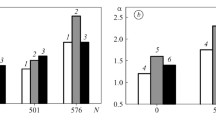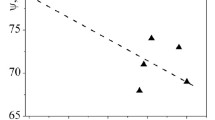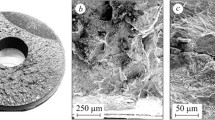We analyze the mechanical properties of heat-resistant steels after long-term operation at thermal power plants. It is shown that the operating conditions (high temperature and pressure of hydrogenating corrosive media, thermal and mechanical stresses) negatively affect their structural-mechanical state. We generalize the results of evaluation of the mechanical characteristics of steels after their operation in various elements (straight sections, pipe bends, and welded joints) of the main steam pipelines of thermal power plants under the joint influence of the in-service factors. On this basis, we rank the analyzed steels according to their sensitivity to high-temperature hydrogen degradation.



Similar content being viewed by others
References
O. Yu. Chernousenko and V. A. Peshko, “Influence of the operation of power-generating units of thermal power plants in the maneuvering mode on the exhaustion of the service life of power-generating plants,” Visn. NTU “KhPI”, No. 10 (1182), 6–16 (2016).
Z. T. Nazarchuk and H. M. Nykyforchyn, “Structural and corrosion fracture mechanics as components of the physicochemical mechanics of materials,” Fiz.-Khim. Mekh. Mater., 54, No. 1, 17–30 (2018); English translation: Mater. Sci., 54, No. 1, 7–21 (2018).
J. Dobrzański, H. Krztoń, and A. Zieliński, “Development of the precipitation processes in low-alloy Cr–Mo type steel for evolution of the material state after exceeding the assessed lifetime,” J. Achiev. Mater. Manuf. Eng., 23, No. 2, 19–22 (2007).
O. P. Ostash, O. V. Vol’demarov, P. V. Hladysh, and A. D. Ivasyshyn, “Evaluation of the degradation of steels of steam pipelines according to their structural, mechanical, and electrochemical characteristics,” Fiz.-Khim. Mekh. Mater., 46, No. 4, 5–12 (2010); English translation: Mater. Sci., 46, No. 4, 431–439 (2011).
I. R. Dzioba, “Properties of 13KhMF steel after operation and degradation under the laboratory conditions,” Fiz.-Khim. Mekh. Mater., 46, No. 3, 67–72 (2010); English translation: Mater. Sci., 46, No. 3, 357–364 (2010).
H. V. Krechkovs’ka and O. Z. Student, “Determination of the degree of degradation of steels of steam pipelines according to their impact toughness on specimens with different geometries of notches,” Fiz.-Khim. Mekh. Mater., 52, No. 4, 106–110 (2016); English translation: Mater. Sci., 52, No. 4, 566–571 (2017).
P. V. Yasniy, P. O. Maruschak, S. V. Panin, and R. T. Bishchak, “Scale levels of deformation and fracture and mechanical properties of 25CrlMolV steel before and after nonisothermal loading,” Phys. Mesomech., 14 (1–2), 57–65 (2011).
О. Z. Student, H. V. Krechkovska, L. М. Svirska, and P. R. Solovei, “Restoration of the properties of heat-resistant steel after long-term operation in a steam turbine,” Fiz.-Khim. Mekh. Mater., 57, No. 1, 69–77 (2021); English translation: Mater. Sci., 57, No. 1, 71–79 (2021).
O. M. Romaniv, H. M. Nykyforchyn, I. R. Dzioba, and B. P. Lonyuk, “Effect of damage in service of 12Kh1MF steam-pipe steel on its crack resistance characteristics,” Fiz.-Khim. Mekh. Mater., 34, No. 1, 101–104 (1998); English translation: Mater. Sci., 34, No. 1, 110–114 (1998).
P. O. Maruschak, D. Y. Baran, A. P. Sorochak, R. T. Bishchak, and V. P. Yasnii, “Cyclic crack resistance and micromechanisms of fracture of steel 25Kh1M1F,” Probl. Prochn., 44, No. 4, 88–98 (2012); English translation: Strength Mater., 44, No. 4, 410–418 (2012).
H. V. Krechkovs’ka, O. Z. Student, and H. M. Nykyforchyn, “Diagnostics of the engineering state of steam pipelines of thermal power plants by the hardness and crack resistance of steel,” Fiz.-Khim. Mekh. Mater., 54, No. 5, 22–32 (2018); English translation: Mater. Sci., 54, No. 5, 627–637 (2019).
Standard Test Method for J-Integral Characterization of Fracture Toughness. ASTM. E 1737, Unified Method of Test for the Determination of Quasistatic Fracture Toughness. Draft International Standard ISO/DIS 12135.
H. M. Nykyforchyn, O. Z. Student, and A. D. Markov, “Abnormal manifestation of the high-temperature degradation of the weld metal of a low-alloy steel welded joint,” Fiz.-Khim. Mekh. Mater., 43, No. 1, 73–79 (2007); English translation: Mater. Sci., 43, No. 1, 77–84 (2007).
O. Student, “Hydrogen effect on properties of heat resistance steels after their high temperature hydrogen degradation in laboratory and service conditions,” in: Proc. of the18th Europ. Conf. on Fracture, ECF-18 “Fracture of Materials and Structures from Micro and Macro Scale”, Dresden, Germany (2010), ESIS, DVM, 2010, CD ROM, Proceeding ID 154: 9348 3B D 11357.
H. M. Nykyforchyn, O. Z. Student, H. V. Krechkovs’ka, and A. D. Markov, “Evaluation of the influence of shutdowns of a technological process on changes in the in-service state of the metal of main steam pipelines of thermal power plants,” Fiz.-Khim. Mekh. Mater., 46, No. 2, 42–54 (2010); English translation: Mater. Sci., 46, No. 2, 177–189 (2010).
H. М. Nykyforchyn, O. Z. Student, І. R. Dzioba, S. М. Stepanyuk, A. D. Markov, and Ya. D. Onyshchak, “Degradation of welded joints of steam pipelines of thermal electric power plants in hydrogenating media,” Fiz.-Khim. Mekh. Mater., 40, No. 6, 105–110 (2004); English translation: Mater. Sci., 40, No. 6, 836–843 (2004).
O. Student and A. Markov, “Hydrogen effect on the mechanical properties and fracture mechanism of the degraded welded joints from steam pipeline,” in: Ja. Pokluda, P. Sandera, P. Lukas, and I. Dlouhy (editors), Proc. of 17th Europ. Conf. on Fracture 2008: “Multilevel Approach to Fracture of Materials, Components and Structures” (September 2–5, 2008, Brno, Czech Republic), Vol. 3, Curran Associates, Inc., New York (2011), pp. 2299–2307.
O. I. Zvirko, E. I. Kryzhanivskyi, H. M. Nykyforchyn, and H. V. Krechkovs’ka, “Methods for the evaluation of corrosion-hydrogen degradation of steels of oil-and-gas pipelines,” Fiz.-Khim. Mekh. Mater., 56, No. 5, 7–14 (2020); English translation: Mater. Sci., 56, No. 5, (2020).
О. Z. Student, H. V. Krechkovs’ka, T. E. Palashchuk, and Ya. М. Hladkyi, “Influence of the long-term operation of 12Kh1МF steel of the bends of main steam pipelines of thermal power plants on its mechanical properties,” Fiz.-Khim. Mekh. Mater., 53, No. 4, 4–41 (2017); English translation: Mater. Sci., 53, No. 4, 460–467 (2018).
L. O. Babii, O. Z. Student, A. Zagórski, and A. D. Markov, “Creep of degraded 2.25Cr–Mo steel in hydrogen,” Fiz.-Khim. Mekh. Mater., 43, No. 5, 91–96 (2007); English translation: Mater. Sci., 43, No. 5, 701–707 (2007).
O. D. Smiyan and O. Z. Student, “Fractographic signs of gigacycle fatigue and hydrogenation of heat-resistant steels after long-term operation,” Fiz.-Khim. Mekh. Mater., 56, No. 6, 5–15 (2020); English translation: Mater. Sci., 56, No. 6, 727–738 (2021).
Author information
Authors and Affiliations
Corresponding author
Additional information
Translated from Fizyko-Khimichna Mekhanika Materialiv, Vol. 57, No. 3, pp. 110–117, May–June, 2021
Rights and permissions
About this article
Cite this article
Student, O.Z., Krechkovska, H.V., Svirska, L.М. et al. Ranking of the Mechanical Characteristics of Steels of Steam Pipelines of Thermal Power Plants by Their Sensitivity to In-Service Degradation. Mater Sci 57, 404–412 (2021). https://doi.org/10.1007/s11003-021-00554-x
Received:
Published:
Issue Date:
DOI: https://doi.org/10.1007/s11003-021-00554-x




